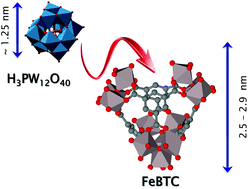Heteropolyacid encapsulation into the MOF: influence of acid particles distribution on ethanol conversion in hybrid nanomaterials†
Abstract
Hybrid nanomaterials comprising tungsten heteropolyacid (HPW) and iron-based MOF Basolite™ F 300 used as a support were obtained by post-synthesis combination of the two components. Samples with increasing HPW loading (20, 50, and 80 wt%) were characterised by appropriate physicochemical methods, including nitrogen sorption, electron microscopy imaging, FT-IR spectroscopy, sorption microbalance and catalytic tests. The acidic protons of the tungsten-based heteropolyacid catalysed ethanol conversion depending on location of HPW at either internal or external surfaces of the commercial Basolite™ F 300.


 Please wait while we load your content...
Please wait while we load your content...